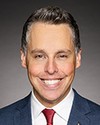Thank you.
The structure-conduct-performance framework is a useful paradigm for considering the state of competition in the airline industry. Structure refers to the number of players, the similarity of product, and the cost of entry and exit.
Domestic competition in Canada is limited to four scheduled passenger airlines, excluding Arctic and remote communities. Air Canada and WestJet, which are full-service airlines, account for over 80% of the market. They operate airport hubs to serve domestic, transborder and international passenger services as well as cargo services. The two smaller airlines, Flair and Porter, operate point-to-point services with niche strategies. Flair positions itself as a discount carrier, while Porter offers non-price benefits and caters more to a business market.
For many consumers, air travel has become a commodity. All companies use the same planes, with minimal differences in non-price attributes of service. The geography of the market also matters. The narrow, linear shape of the Canadian market means that all competitors fly the same parallel routes across the country, leaving scant room for differentiation.
Entry and exit costs depend on the industry's ratio of fixed to variable costs. A high proportion of fixed costs favours industry concentration; however, some costs can be made semi-variable, such as leasing aircraft and subcontracting labour like baggage handling. The largest variable cost is fuel. Entry costs involve setting up a reservation system, labour contracts, renting airport space and maintenance operations. Industry exit is easier, but these are sunk costs.
Large airlines experience economies of scale and size. The more origin-destination pairs in their network, the bigger their customer base. Size also enables airlines to form hub-and-spoke networks. Larger aircraft, which are more profitable, can be deployed from hub locations where they benefit from the S-curve. The S-curve observation is that, as airlines increase flights at an airport, they receive a disproportionate share of passengers. Economies of size also apply to the cost of operations, such as hangars, maintenance and overhead expenses.
The conduct of firms is generally opaque because regulations exist to curb anti-competitive behaviour such as price-fixing, misrepresentation and abuse of a dominant position. In an oligopolistic market, however, tacit collusion is possible. The major players can react to each other's moves with an eye to sharing the market and maximizing their profits.
Until the 1980s, air conduct was subject to strict price and route regulation, with the goals of stability and consumer protection. Deregulation of the airlines was based on the theory of contestable markets. Essentially, this theory holds that the participants in a market with few rivals could conduct themselves in a competitive manner if the threat of new entrants was sufficient to cause them to focus on sales rather than profits.
The history of Canadian airlines since deregulation has supported the reliance on contestable market theory. The number of new entrants entering and exiting has kept the market competitive. For example, the big airlines set up discount subsidiaries to meet the challenge posed by new entrants by matching their fares and routes.
The performance of the airlines is measured by their profitability and efficiency. Profitability is easier to assess for publicly traded companies than efficiency. In general, investors have viewed the profitability of scheduled air carriers as less attractive than most publicly traded companies. Nonetheless, the major airlines have been relatively stable, with mergers rather than bankruptcies being the predominant outcome.
Whether air service in Canada is as efficient as it could be is clouded by protectionism. Domestic competition is constrained by cabotage restrictions that prohibit foreign airlines from operating within the Canadian market. Also, foreign ownership controls restrict access to international investment capital that could lead to more efficient scale and fleet renewal.
Although ticket prices are rising, so are costs for labour, equipment and fuel that could impact competition. All airlines have experienced higher wage settlement demands as workers try to catch up with inflation. The worldwide demand for air pilots has caused wage increases well above the rate of inflation. The threatened strike by WestJet's aircraft maintenance fraternal organization is the latest example of this.
Rising interest rates add to the cost base of this capital-intensive industry. The low exchange rate value of the Canadian dollar also matters, because most aircraft and parts are imported. Oil prices are currently low, but fuel prices will rise with carbon taxes and the adoption of sustainable aviation fuels.
Finally, the losses incurred during the pandemic are unlikely to be extinguished already.
The impact of ticket prices on demand for air travel in Canada is also affected by fees and charges that are outside the domain of the airlines. The Canadian airports have raised fees to deal with debts that were incurred during the pandemic. The Government of Canada continues to extract rent payments from the airports and user fees for security that ultimately are all paid by the consumer.
The weak economy, and the possibility that it may dip into a recession, does not bode well for passenger demand. Air travel is more a luxury than a necessity for most leisure passengers. Business travel has also been cut by the pandemic experience and a shift to virtual meetings, although some revival may be occurring.
Since deregulation, airline competition in Canada has resulted in two large scheduled carriers and the entry and exit of a series of smaller carriers. The recent loss of a very small airline, Lynx, does not mean that further contraction is inevitable, but instability is the price of efficiency—




